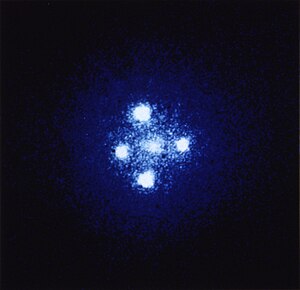
Back تقاطع أينشتاين Arabic Крыж Эйнштэйна Byelorussian Creu d'Einstein Catalan Einsteinův kříž Czech Einsteinkreuz German Σταυρός του Αϊνστάιν Greek Cruz de Einstein Spanish صلیب اینشتین Persian Einsteinin risti Finnish Croix d'Einstein French
| Einstein Cross | |
|---|---|
 | |
| Observation data (Epoch J2000) | |
| Constellation | Pegasus |
| Right ascension | 22h 40m 30.3s |
| Declination | +3° 21′ 31″ |
| Redshift | 1.695 |
| Distance | 8,000,000,000 ly (2,500,000,000 pc) |
| Type | LeQ |
| Apparent dimensions (V) | less than 2" |
| Apparent magnitude (V) | 16.78 |
| Other designations | |
| LEDA 69457, Z 378-15 | |
| See also: Quasar, List of quasars | |
The Einstein Cross (Q2237+030 or QSO 2237+0305) is a gravitationally lensed quasar that sits directly behind the centre of the galaxy ZW 2237+030, called Huchra's Lens. Four images of the same distant quasar (plus one in the centre, too dim to see) appear in the middle of the foreground galaxy due to strong gravitational lensing.[1][2] This system was discovered by John Huchra and coworkers in 1985, although at the time they only detected that there was a quasar behind a galaxy based on differing redshifts and did not resolve the four separate images of the quasar.[3]
While gravitationally lensed light sources are often shaped into an Einstein ring, due to the elongated shape of the lensing galaxy and the quasar being off-centre, the images form a peculiar cross-shape instead.[4]
Other "Einstein crosses" have been discovered[5][6] (see image below of one of them).
- ^ NASA and ESA (September 13, 1990). "The Gravitational Lens G2237 + 0305". HubbleSite. Archived from the original on 19 December 2005. Retrieved July 25, 2006.
- ^ Drakeford, Jason; Corum, Jonathan; Overbye, Dennis (March 5, 2015). "Einstein's Telescope - video (02:32)". The New York Times. Retrieved December 27, 2015.
- ^ Huchra, J.; et al. (1985). "2237 + 0305: A new and unusual gravitational lens". Astronomical Journal. 90: 691–696. Bibcode:1985AJ.....90..691H. doi:10.1086/113777.
- ^ "How does gravitational lensing account for Einstein's Cross?". physics.stackexchange.com. Retrieved 2016-06-26.
- ^ Instituto de Astrofísica de Canarias. "A new Einstein cross is discovered". phys.org. Retrieved 2019-11-13.
- ^ Bettoni, Daniela; et al. (2019). "A New Einstein Cross Gravitational Lens of a Lyman-break Galaxy". Astrophysical Review Letters. 873 (2): L14. arXiv:1902.10964. Bibcode:2019ApJ...873L..14B. doi:10.3847/2041-8213/ab0aeb.